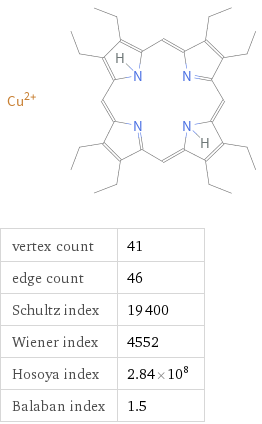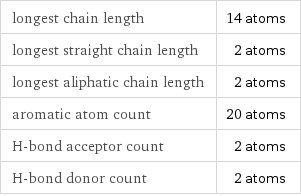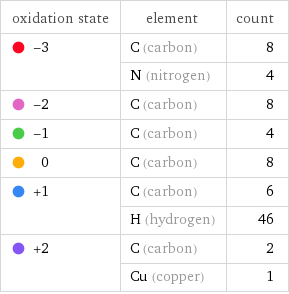Input interpretation

2, 3, 7, 8, 12, 13, 17, 18-octaethyl-21H, 23 H-porphine copper(II)
Basic properties
![molar mass | 598.3 g/mol formula | (C_36H_46CuN_4)^2+ empirical formula | Cu_C_36N_4H_46 SMILES identifier | CCC1=C(CC)C2=CC3=NC(=CC4=C(CC)C(=C(C=C5C(=C(CC)C(=N5)C=C1N2)CC)N4)CC)C(=C3CC)CC.[Cu+2] InChI identifier | InChI=1/C36H46N4.Cu/c1-9-21-22(10-2)30-18-32-25(13-5)26(14-6)34(39-32)20-36-28(16-8)27(15-7)35(40-36)19-33-24(12-4)23(11-3)31(38-33)17-29(21)37-30;/h17-20, 37, 40H, 9-16H2, 1-8H3;/q;+2 InChI key | JPXFQQJEMLFHGU-UHFFFAOYSA-N](../image_source/9b188f8a3e12be6cc2e90925bc4950df.png)
molar mass | 598.3 g/mol formula | (C_36H_46CuN_4)^2+ empirical formula | Cu_C_36N_4H_46 SMILES identifier | CCC1=C(CC)C2=CC3=NC(=CC4=C(CC)C(=C(C=C5C(=C(CC)C(=N5)C=C1N2)CC)N4)CC)C(=C3CC)CC.[Cu+2] InChI identifier | InChI=1/C36H46N4.Cu/c1-9-21-22(10-2)30-18-32-25(13-5)26(14-6)34(39-32)20-36-28(16-8)27(15-7)35(40-36)19-33-24(12-4)23(11-3)31(38-33)17-29(21)37-30;/h17-20, 37, 40H, 9-16H2, 1-8H3;/q;+2 InChI key | JPXFQQJEMLFHGU-UHFFFAOYSA-N
Structure diagram

vertex count | 41 edge count | 46 Schultz index | 19400 Wiener index | 4552 Hosoya index | 2.84×10^8 Balaban index | 1.5
Quantitative molecular descriptors

longest chain length | 14 atoms longest straight chain length | 2 atoms longest aliphatic chain length | 2 atoms aromatic atom count | 20 atoms H-bond acceptor count | 2 atoms H-bond donor count | 2 atoms
Elemental composition
![Find the elemental composition for SMILES:[Cu+2].C(C)C1=C2NC(=C1CC)C=C1C(=C(C(=N1)C=C1C(=C(C(N1)=CC=1C(=C(C(N1)=C2)CC)CC)CC)CC)CC)CC in terms of the atom and mass percents: atom percent = N_i/N_total × 100% mass percent = (N_im_i)/m × 100% Plan: • Write the chemical formula and gather atomic masses from the periodic table. • Determine values for N_i, m_i, N_total and m using these items. • Finally, compute the percents and check the results. Write the chemical formula: (C_36H_46CuN_4)^2+ Use the chemical formula to count the number of atoms, N_i, for each element and find the total number of atoms, N_total: | number of atoms Cu (copper) | 1 C (carbon) | 36 N (nitrogen) | 4 H (hydrogen) | 46 N_total = 1 + 36 + 4 + 46 = 87 Divide each N_i by N_total to calculate atom fractions. Then use the property that atom fractions must sum to one to check the work: | number of atoms | atom fraction Cu (copper) | 1 | 1/87 C (carbon) | 36 | 36/87 N (nitrogen) | 4 | 4/87 H (hydrogen) | 46 | 46/87 Check: 1/87 + 36/87 + 4/87 + 46/87 = 1 Compute atom percents using the atom fractions: | number of atoms | atom percent Cu (copper) | 1 | 1/87 × 100% = 1.15% C (carbon) | 36 | 36/87 × 100% = 41.4% N (nitrogen) | 4 | 4/87 × 100% = 4.60% H (hydrogen) | 46 | 46/87 × 100% = 52.9% Look up the atomic mass, m_i, in unified atomic mass units, u, for each element in the periodic table: | number of atoms | atom percent | atomic mass/u Cu (copper) | 1 | 1.15% | 63.546 C (carbon) | 36 | 41.4% | 12.011 N (nitrogen) | 4 | 4.60% | 14.007 H (hydrogen) | 46 | 52.9% | 1.008 Multiply N_i by m_i to compute the mass for each element. Then sum those values to compute the molecular mass, m: | number of atoms | atom percent | atomic mass/u | mass/u Cu (copper) | 1 | 1.15% | 63.546 | 1 × 63.546 = 63.546 C (carbon) | 36 | 41.4% | 12.011 | 36 × 12.011 = 432.396 N (nitrogen) | 4 | 4.60% | 14.007 | 4 × 14.007 = 56.028 H (hydrogen) | 46 | 52.9% | 1.008 | 46 × 1.008 = 46.368 m = 63.546 u + 432.396 u + 56.028 u + 46.368 u = 598.338 u Divide the mass for each element by m to calculate mass fractions. Then use the property that mass fractions must sum to one to check the work: | number of atoms | atom percent | mass fraction Cu (copper) | 1 | 1.15% | 63.546/598.338 C (carbon) | 36 | 41.4% | 432.396/598.338 N (nitrogen) | 4 | 4.60% | 56.028/598.338 H (hydrogen) | 46 | 52.9% | 46.368/598.338 Check: 63.546/598.338 + 432.396/598.338 + 56.028/598.338 + 46.368/598.338 = 1 Compute mass percents using the mass fractions: Answer: | | | number of atoms | atom percent | mass percent Cu (copper) | 1 | 1.15% | 63.546/598.338 × 100% = 10.62% C (carbon) | 36 | 41.4% | 432.396/598.338 × 100% = 72.27% N (nitrogen) | 4 | 4.60% | 56.028/598.338 × 100% = 9.364% H (hydrogen) | 46 | 52.9% | 46.368/598.338 × 100% = 7.749%](../image_source/843adc3aeff967c7d696877ae3c89e2c.png)
Find the elemental composition for SMILES:[Cu+2].C(C)C1=C2NC(=C1CC)C=C1C(=C(C(=N1)C=C1C(=C(C(N1)=CC=1C(=C(C(N1)=C2)CC)CC)CC)CC)CC)CC in terms of the atom and mass percents: atom percent = N_i/N_total × 100% mass percent = (N_im_i)/m × 100% Plan: • Write the chemical formula and gather atomic masses from the periodic table. • Determine values for N_i, m_i, N_total and m using these items. • Finally, compute the percents and check the results. Write the chemical formula: (C_36H_46CuN_4)^2+ Use the chemical formula to count the number of atoms, N_i, for each element and find the total number of atoms, N_total: | number of atoms Cu (copper) | 1 C (carbon) | 36 N (nitrogen) | 4 H (hydrogen) | 46 N_total = 1 + 36 + 4 + 46 = 87 Divide each N_i by N_total to calculate atom fractions. Then use the property that atom fractions must sum to one to check the work: | number of atoms | atom fraction Cu (copper) | 1 | 1/87 C (carbon) | 36 | 36/87 N (nitrogen) | 4 | 4/87 H (hydrogen) | 46 | 46/87 Check: 1/87 + 36/87 + 4/87 + 46/87 = 1 Compute atom percents using the atom fractions: | number of atoms | atom percent Cu (copper) | 1 | 1/87 × 100% = 1.15% C (carbon) | 36 | 36/87 × 100% = 41.4% N (nitrogen) | 4 | 4/87 × 100% = 4.60% H (hydrogen) | 46 | 46/87 × 100% = 52.9% Look up the atomic mass, m_i, in unified atomic mass units, u, for each element in the periodic table: | number of atoms | atom percent | atomic mass/u Cu (copper) | 1 | 1.15% | 63.546 C (carbon) | 36 | 41.4% | 12.011 N (nitrogen) | 4 | 4.60% | 14.007 H (hydrogen) | 46 | 52.9% | 1.008 Multiply N_i by m_i to compute the mass for each element. Then sum those values to compute the molecular mass, m: | number of atoms | atom percent | atomic mass/u | mass/u Cu (copper) | 1 | 1.15% | 63.546 | 1 × 63.546 = 63.546 C (carbon) | 36 | 41.4% | 12.011 | 36 × 12.011 = 432.396 N (nitrogen) | 4 | 4.60% | 14.007 | 4 × 14.007 = 56.028 H (hydrogen) | 46 | 52.9% | 1.008 | 46 × 1.008 = 46.368 m = 63.546 u + 432.396 u + 56.028 u + 46.368 u = 598.338 u Divide the mass for each element by m to calculate mass fractions. Then use the property that mass fractions must sum to one to check the work: | number of atoms | atom percent | mass fraction Cu (copper) | 1 | 1.15% | 63.546/598.338 C (carbon) | 36 | 41.4% | 432.396/598.338 N (nitrogen) | 4 | 4.60% | 56.028/598.338 H (hydrogen) | 46 | 52.9% | 46.368/598.338 Check: 63.546/598.338 + 432.396/598.338 + 56.028/598.338 + 46.368/598.338 = 1 Compute mass percents using the mass fractions: Answer: | | | number of atoms | atom percent | mass percent Cu (copper) | 1 | 1.15% | 63.546/598.338 × 100% = 10.62% C (carbon) | 36 | 41.4% | 432.396/598.338 × 100% = 72.27% N (nitrogen) | 4 | 4.60% | 56.028/598.338 × 100% = 9.364% H (hydrogen) | 46 | 52.9% | 46.368/598.338 × 100% = 7.749%
Elemental oxidation states

oxidation state | element | count -3 | C (carbon) | 8 | N (nitrogen) | 4 -2 | C (carbon) | 8 -1 | C (carbon) | 4 0 | C (carbon) | 8 +1 | C (carbon) | 6 | H (hydrogen) | 46 +2 | C (carbon) | 2 | Cu (copper) | 1